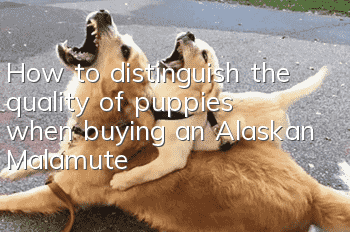How to distinguish the quality of puppies when buying an Alaskan Malamute

Regarding the quality of puppies, it takes a long time of breeding experience to distinguish the quality of each puppy, which cannot be summarized in a few simple sentences. But for buyers, to put it simply, they mainly look at the bone mass, hair volume and front page.
When comparing puppies of the same age, of course it must be based on their actual age. Those with thick bones, wide chests, lots of hair, big heads, and short and thick mouths are usually of better quality. But there are also acquired factors. Breeding methods are very important. If the dog is raised well, the dog will grow up to be very beautiful. If it is not raised well, the dog will be born with a good appearance, and it may not be ideal when it grows up. But we can’t rely entirely on acquired feeding. Good feeding can only be said to bring out its due limit, not its extraordinary performance. To give a simple example, a naturally short person will never grow up to be like Yao Ming no matter how well he eats since childhood. .
Another thing to say is that the photos are not completely trustworthy and may have visual differences. It is best to have reference objects in the photos of the puppies, such as using a drink bottle to compare the legs on the horizontal line, etc.
Regarding the teeth, you can judge the age of the baby by looking at the teeth. The teeth will gradually grow unevenly in about 20 days. In 30-40 days, the deciduous incisors will all grow in length. At 2 months, all the baby teeth have grown in, are pointed and tender white. 4 months later, the first deciduous incisor is replaced. At 5-6 months, the second and third deciduous incisors and all deciduous canines are replaced. Over 8 months old, all teeth are replaced by permanent teeth. 1 year old, the permanent teeth are all long, smooth and strong, with sharp protrusions on the upper part of the incisors. At 1.5 years old, the peak of the first mandibular incisor disappeared. At 2.5 years old, the peak of the second mandibular incisor disappeared. At 3.5 years old, the peak of the maxillary first incisor was lost. At 4.5 years old, the peak of the maxillary second incisor was lost. At the age of 5, the peak of the third mandibular incisor was slightly worn, and at the same time, the first and second mandibular incisors were ground into a rectangular shape. At 6 years old, the peak of the third mandibular incisor was lost and the canine teeth were blunt and rounded. At the age of 7, the first incisor of the mandible was worn to the root of the tooth, and the worn surface was vertically oval. At the age of 8, the first incisor of the mandible was worn and tilted forward. At 10 years old, the wear surfaces of the second mandibular and first maxillary incisors were longitudinally oval in shape. At the age of 16, the incisors were lost and the canines were incomplete. At the age of 20, the canine teeth fell out. Judging age by looking at teeth requires extensive experience and more observation.
Regarding snow nose and nose flowers in Alaska, dogs with snow nose include Husky, Alaskan, Golden Retriever, Labrador, etc., mainly Alaska. The so-called snow nose refers to a vertical pink stripe appearing in the middle of the nose. Snow nose can appear on the nose of any color Husky or Alaskan. The formation of snow nose is directly related to an enzyme in the body. The enzyme responsible for producing black/liver-colored pigment on the nose is affected by temperature. These enzymes are active when the temperature is high, that is to say, they appear in winter. For dogs with snow nose, it can be alleviated or disappear in summer, but in winter, this enzyme becomes inactive, so snow nose becomes obvious. There is no way to completely improve snow nose. Although many friends use minerals, seaweed powder or other nutrients to change snow nose in a short time, if you stop using these items, snow nose will appear immediately. For additionalA flowered nose (that is, an irregular pink nose appears on the nose) can be completely improved with nutritional supplements containing minerals and exposure to the sun. This flowered nose is completely different from a snowy nose. In dog shows around the world, points will not be deducted for Huskies and Alaskan snow noses, which means that snow nose is not a fault.
- How to treat diarrhea in poodles? Treat gastrointestinal problems in dogs!
- Do Huskies exercise a lot? How much exercise does a Husky do in a day?
- How to brush your Husky’s teeth? Teach you how to brush your Husky’s teeth!
- What medicine should a two-month-old puppy take if it has diarrhea?
- What are the physical characteristics of spaniels? Are they easy to raise? How to raise them?
- What to do if your Irish Setter has tear stains
- Don’t take it seriously if your dog has diarrhea, he may be infected with parvovirus.
- What are the causes of sudden vomiting in Chow Chows? What kind of medicine is good?
- What do dogs eat to make their fur shine?
- How to raise silver fox dogs in summer



